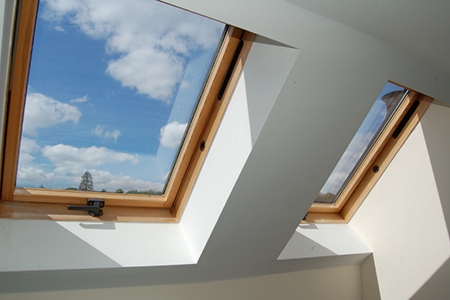 If you’re looking for a way to add style and value to your home, skylights might be the perfect solution. It will take some planning, but a well-designed skylight comes with a multitude of benefits — not just beauty and value, but possibly energy savings and health benefits, as well. Here is an in-depth look at some of the rewards that skylights can bring to your home.
If you’re looking for a way to add style and value to your home, skylights might be the perfect solution. It will take some planning, but a well-designed skylight comes with a multitude of benefits — not just beauty and value, but possibly energy savings and health benefits, as well. Here is an in-depth look at some of the rewards that skylights can bring to your home.
Letting Natural Light into Your Home
It isn’t easy to fill your home with natural lighting. Some rooms have limited (or no) exterior walls for windows. In the rooms that do have windows, you likely use curtains or blinds for privacy. Skylights are an excellent way to bathe your home in sunlight without giving your neighbors a view.
Make sure to align your skylights according to the type of natural lighting that you want. Southern-facing skylights will give rooms a sun-kissed look, but they can also heat those rooms during the summer. Eastern- and western-facing skylights will let the light in as the sun rises or sets, and northern skylights add cooler, more diffused lighting to rooms since the sun doesn’t shine directly into them.
Saving on Heating and Cooling Bills
A poorly planned skylight can wreak havoc on your energy bills, but with some thought as to the positioning and design of your skylights, you can save money on heating and cooling costs. South-facing skylights will increase the temperature of your home year-round because they will pick up more of the sun’s rays than a skylight facing in any other direction.
In the winter, you can use this to your advantage — let the sun shine and heat your home so that you can shave money off your heating costs. In the summer, however, uncovered skylights can make rooms uncomfortably hot. The solution to this is to choose a skylight design that features built-in shades so that you can block the sunlight during the hottest parts of the day. If your skylight opens, that’s a bonus. Heat rises, which means you can open your skylights on summer nights to vent the heat from the day out of your home.
Adding Architectural Interest Inside and Out
Skylights are unusual in that they’re one of the very few home improvements that give you the chance to upgrade both the interior and the exterior of your home at the same time. As such, they can make your home very attractive to potential buyers and can dramatically increase the home’s value. To get beauty and value from a skylight, however, it needs to be an architectural asset. That is, you’ll need to balance it with your home’s architectural theme and features. In traditional homes, you’re better off installing skylights to the rear of the home or in an area where they’ll be out of sight from the street. This is because skylights have a modern aesthetic that contrasts with traditional styles. Prominent placement may take something away from your home’s traditional charm.
On the inside, make sure that the skylight coordinates with the rest of the room. Rather than placing the skylight wherever it is most convenient to install, align it with a door or a window, or think of another way to place the skylight so that it makes sense from a geometric standpoint. Lastly, ensure that the skylight is large enough to stand out — smaller skylights tend to be more of a distraction than an asset.
Preventing Seasonal Affective Disorder
According to the Mayo Clinic, seasonal affective disorder (SAD) causes depression, fatigue, irritability and other less-than-pleasant symptoms. For most people, these symptoms start in the fall and extend throughout the winter, but it is possible to suffer from SAD in the spring and summer.
The problem is, during fall and winter, you’re not exposed to as much sunlight. This not only throws your natural circadian rhythm out of balance, but it also causes a decrease in serotonin and melatonin levels. Skylights, because they add so much natural sunlight to a home, are one of the recommended treatments to help you prevent and recover from this disorder.
It’s because of these advantages and others that skylights are rapidly gaining popularity. If you choose to install them in your home, think about the things mentioned above to get the most out of this home improvement project.
Chuck Tripp has over 20 years of experience in the residential stock house plan industry. He is currently the Sales & Marketing Director of Donald A. Gardner Architects, Inc., a house planning company that has been developing floor plans since 1978.
This post was originally published on RISMedia’s blog, Housecall. Check the blog daily for winning real estate tips and trends.



